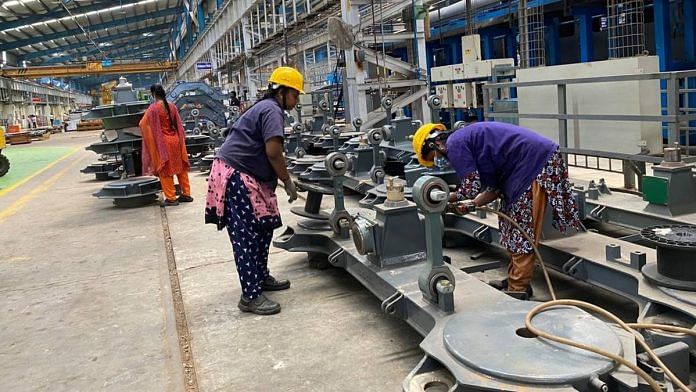Mumbai: A paper published by a researcher at Ashoka University’s Centre for Economic Data and Analysis (CEDA) has flagged major gender gaps in India’s manufacturing sector.
The research is based on the 2019–20 Annual Survey of Industries (ASI) data, which claimed that less than a fifth of the eight million people who worked in India’s factories in 2019–20 were women. It added that this share had largely remained unchanged for two decades.
The paper also pointed out that ASI provides gender-segregated data only for “direct employees” involved in the manufacturing process but not for workers hired on contract or those involved in “clerical, supervisory, managerial, sales, watch and ward staff.”
In the paper published Monday, CEDA’s Dhruvika Dhamija wrote about the wide regional and industry-wide variations among this small share of women in the manufacturing sector.
“Of the 1.6 million women workers across India, 0.68 million (43 per cent) were working in the factories of Tamil Nadu alone. In fact, nearly three-fourths (72 per cent) of all women working in industries were employed in the four southern states of Tamil Nadu, Karnataka, Andhra Pradesh and Kerala,” Dhruvika Dhamija, the author of the CEDA paper, has observed in her paper.
In addition, the gender gap varies widely across states, she noted.
“Manipur is the only state with a gender balance among those working in its manufacturing sector. The share of women workers in the state stood at 50.8 per cent in 2019-20. Manipur was followed by Kerala (45.5 percent), Karnataka (41.8 percent) and Tamil Nadu (40.4 percent),” she wrote.
According to Dhamija, Chhattisgarh had the most gender-skewed industrial workforce, with women making up just 2.9 per cent of those working in the state’s manufacturing units. This was followed by Delhi, where women comprised 4.7 per cent of the workforce, and Jammu and Kashmir and West Bengal, where women made up just 5.5 per cent of the total manufacturing workforce.
Also read: Unemployment rise in India isn’t due to Covid alone. See what data says
‘Women likely to be working only in handful of industries’
The percentage of women workers in the manufacturing sector varied across India’s most-industrialised states, “with Maharashtra (12 per cent), Uttar Pradesh (5.7 per cent) and Gujarat (6.8 per cent) having large gender gaps and Tamil Nadu (40.4 per cent) and Andhra Pradesh (30.2 per cent) faring much better. Women’s share among industrial employees was less than 10 per cent in 16 states and union territories.”
Dhamija added that women were likely to be working only in a handful of industries.
Among major industries — those that employed 50,000 workers or more — women outnumbered men only in tobacco and met them halfway in the “wearing apparel” sector, but were significantly outnumbered in the rest.
Incidentally, in five of the 22 major industry groups, such as food products, chemicals, and computers, women’s employment registered a significant fall in the decade 2009-2019.
“Food products had seen the largest fall in female employment with employment dropping by 16 per cent in 2019 as compared to 2009. Other industries that saw a decline in the number of women workers were chemicals, computers and opticals, printing and reproduction of media and motor vehicles. In contrast, industries like fabricated metals, leather products, machinery and other transport saw a doubling of the number of female workers in this period,” the paper claimed.
The research also touched upon salaries, pointing out that women workers earn much less than men. According to ASI 2019-20, a female industrial worker made an average of Rs 382 per day, compared to Rs 439 earned by male workers. “In simpler terms, that means that for every INR 100 a male industrial worker earned as wages in 2019-20, his female counterpart earned only INR 87.06,” Dhamija wrote.
Also read: NHRC issues notice to Centre, States over high death rate of workers in factories



